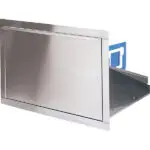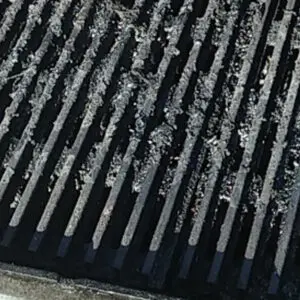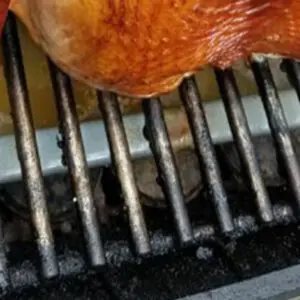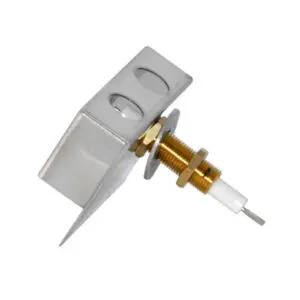
If you entertain often, built-in grills will provide an impressive focal point to your outdoor entertainment area. A built-in grill is finished only on the top and front and fits in a surrounding base that provides support. When considering a built-In grill you will need to answer a few questions before making your decision. We have outlined some of those questions below.
We strongly recommend talking to a professional versed in local codes and requirements before creating any outdoor entertainment area.
GAS TYPE
Propane (LP) Gas
Propane grills run on a refillable tank that can be replenished at your local propane supplier. Ideal for those without a natural gas hookup.
Pros
• Easy set-up that produces even heating and quick warm-up time
• Efficient and easy to clean
• Produces odorless fumes and flame
Cons
• Can achieve high cooking temperatures that reach up to 450 degrees
• Fuel tanks need to be replaced regularly when fuel runs out
Natural Gas
Natural gas grills hook up directly to the natural gas line from your house, eliminating the worry about refilling propane tanks or running out of gas during the middle of a cookout.
Pros
- Fuel never needs to be replenished
- More cost-effective over time, especially if you already have natural gas in your home
- Easy to clean
Cons
- Installation can be more expensive than other fuel options
- Not portable
If you don’t have a pre-existing natural gas line, you may consider opting for propane. The installation of a natural gas line can be costly and disruptive, especially if your home is situated further away from the distribution hookup.
All islands require ventilation.
Natural gas and Propane gas have different ventilation requirements. Please consult your local codes to determine any regulations or requirements for your specific area.
GRILL SIZE
A big consideration when deciding on a built-n grill is size.
Think about how you use your grill currently. While it is important to understand how many people you’ll be grilling for most frequently, it’s also important to consider how many more people you’ll be grilling for periodically. Remember, a built-in grill is a long-term commitment, if in doubt, or if you think you might increase the amount of people you will be grilling for, size up.
The primary or main grilling surface is measured in square inches and should be your most important consideration. The secondary work surface includes other areas such as warming racks and side burners.
Small

Grill Head:
Up to 26″
Primary Grilling Surface:
400-495 Sq. In
Burger Count:
Up to 15 burgers
Recommended for:
3-6 people
These grills are well-suited to small cookouts and are ideal if you don’t have a lot of space in your outdoor entertainment area
Mid-Sized

Grill Head:
27″-33″
Primary Grilling Surface:
525-642 Sq. In
Burger Count:
Up to 23 burgers
Recommended for:
6-9 people
This is the most popular and often the ideal size for most grillers.
Large

Grill Head:
34″-42″
Primary Grilling Surface:
642-928 Sq. In
Burger Count:
Up to 33 burgers
Recommended for:
6-9 people
This is the most popular and often the ideal size for most grillers.
X-Large

Grill Head:
43″+”
Primary Grilling Surface:
714-966 Sq. In
Burger Count:
Up to 45 burgers
Recommended for:
9+ people
These big grills are usually for serious grillers or entertainers—offering the largest cooking area and a higher number of burners.
GRILL MATERIALS
A built-in gas grill is a long-term investment so buying a grill that will stand up to the elements is an important consideration. Regardless of which material you choose, regular maintenance will go a long way.
Cast Aluminum
 Permanent mold heavy-duty cast aluminum housings have several advantages:
Permanent mold heavy-duty cast aluminum housings have several advantages:
- Heat Distribution: Cast aluminum grills are known for their excellent heat distribution. They can heat up quickly and evenly, which helps in grilling food consistently.
- Quick Preheating: The efficient heat conductivity of cast aluminum means that these grills preheat quickly, allowing you to start grilling sooner.
- Rust-resistant, durable, and long-lasting: Cast aluminum is a durable material that can withstand outdoor elements and resist rust and corrosion better than some other materials like steel. This makes the grill suitable for outdoor use.
- Lightweight: Cast aluminum is lighter than cast iron, which makes these grills more portable and easier to move around when needed.
- Longevity: A well-maintained cast aluminum grill can have a long lifespan, offering years of reliable use without significant deterioration.
- Low Maintenance: Cast aluminum grills generally require a low level of maintenance. Most impact damage can be repaired.
- Fuel Efficiency: Cast aluminum grills require less fuel to reach and maintain high cooking temperatures, making them relatively fuel-efficient compared to some other types of grills.
- Attractive—can add to the aesthetics of your outdoor space.
Stainless Steel

Stainless steel grill is popular among grill enthusiasts due to its numerous benefits, including:
Durability: Stainless steel is highly durable and resistant to rust, corrosion, and staining. This makes stainless steel grills suitable for outdoor use where they are exposed to various weather conditions.
Longevity: Due to its resistance to rust and corrosion, stainless steel grills tend to have a longer lifespan compared to grills made from other materials.
Easy Maintenance: Stainless steel is relatively easy to clean and maintain. It can be wiped down with a damp cloth to remove grease and food residue.
Aesthetic Appeal: Stainless steel grills have a sleek and modern appearance that many people find visually appealing. They can complement various outdoor design styles.
Heat Retention: Stainless steel retains heat well and distributes it evenly across the grilling surface. This can result in consistent grilling and better searing of food.
High Heat Capacity: Stainless steel can withstand high temperatures without warping or distorting. This makes it suitable for grilling techniques that require intense heat.
Hygienic: Stainless steel is non-porous and doesn’t harbor bacteria or other pathogens. This makes it a more sanitary option for grilling food.
FEATURES
Carefully consider all features since this is a long-term investment. Make sure the grill will be able to accommodate the various types of grilling you want to do.
Lighting
For those who enjoy grilling after the sun sets, a remarkable feature to consider is a grill equipped with LED interior lights or backlit control knobs. Beyond their stylish appeal, these elements offer exceptional functionality. Integrated LED lights bring the grilling surface to life, ensuring you have clear visibility to cook with precision even in low-light conditions. Additionally, they illuminate the control panel, enabling you to effortlessly adjust settings, extending your grilling sessions well into the evening. Experience the perfect blend of aesthetics and practicality with a grill that transforms nighttime grilling.
Grilling (Heat) Zones
Grills can have one or more burners giving you the option to create different heat zones. Do you want nice sear marks on your steak or are you looking to grill up some nice ribs? These two items require different grill techniques to produce the best results. For sear marks, you will want to use direct heat while meats that require low and slow or more than 20 minutes to cook should be grilled using indirect heat. This is where the ability to create different heat zones comes into play.
Burner Options
Burners function as the cornerstone of a gas grill’s performance. Their capacity is typically measured in BTUs, and in general, a higher BTU rating is considered favorable. However, it’s crucial to understand that a grill’s cooking prowess isn’t solely contingent on having the highest BTUs. Numerous other factors, such as the grill’s cooking surface area and the distance between the burners and the food, also significantly influence its cooking performance.
So which one works best for you? We have outlined some of the pros for each burner option.
 Traditional Tube Burners
Traditional Tube Burners
- Ease of use
- Precise temperature control
- Even heat distribution
- Multiple grilling zones
- Easy maintenance
 H-Style Burners
H-Style Burners
- Precise temperature control
- Consistent results
- Maximum fuel-efficiency
- Easy maintenance
 Cast Stainless Steel Burners
Cast Stainless Steel Burners
- Durability
- Even heat distribution
- Multiple grilling zones
 Infrared Burners
Infrared Burners
- High heat for searing
- Reduced flare-ups
- Faster grilling times
 Hybrid Burners
Hybrid Burners
- Versatility
- High heat searing
- Reduced flare-ups
 Convection-Style
Convection-Style
- Even heat distribution
- Versatile grilling options
- Reduced flare-ups
- Easy maintenance
Back Burner/Rotisserie
 The combination of an infrared back burner and a rotisserie offers a unique grilling experience. The intense radiant heat generated by the infrared back burner provides a powerful heat source for searing and cooking food quickly. When used in conjunction with the rotisserie, the rotating motion ensures even exposure to this intense heat, resulting in perfectly cooked food. The rotating action of the rotisserie bastes the food with its own juices, enhancing flavor and tenderness. This combination is especially effective for slow-cooking larger cuts of beef, chicken, and other selections, as well as fruits and vegetables. The result is flavorful, evenly cooked food with a crispy exterior and juicy interior.
The combination of an infrared back burner and a rotisserie offers a unique grilling experience. The intense radiant heat generated by the infrared back burner provides a powerful heat source for searing and cooking food quickly. When used in conjunction with the rotisserie, the rotating motion ensures even exposure to this intense heat, resulting in perfectly cooked food. The rotating action of the rotisserie bastes the food with its own juices, enhancing flavor and tenderness. This combination is especially effective for slow-cooking larger cuts of beef, chicken, and other selections, as well as fruits and vegetables. The result is flavorful, evenly cooked food with a crispy exterior and juicy interior.
ADDITIONAL CONSIDERATIONS
Structure to house your built-in grill
As the name suggests, built-in grills require a kitchen island or other structure where they will be housed. Here are a some considerations when building or installing your outdoor kitchen island. We strongly recommend talking to a professional versed in local codes and requirements before creating any outdoor entertainment area.
Space
The size of your island is completely limited to the outdoor space you have. Since the grill will be installed into the island it is important to make sure that the grill you purchase will fit into the allotted space. To accurately assess the space required for your grill you will need the grill head measurements (and the insulated grill sleeve if needed). Are you adding a side burner? Include those measurements as well.
Popular kitchen island materials
- Wood
While wood is a popular, easily obtainable material for building an outdoor kitchen, we generally do no recommend it. Wood is highly flammable and not a good fit with fire/grilling. It also tends to be highly susceptible to rot and insect damage. - Metal
Metal frames are lightweight, versatile, and relatively affordable but they can break down in inclement weather conditions–especially freeze/thaw cycles. - Concrete
One of the best materials to use for any outdoor kitchen is concrete. It is strong, durable, holds up well to inclement weather and will not corrode or rust.
 Insulated Grill Sleeve
Insulated Grill Sleeve
Built-in grills also require the use of an insulated grill sleeve—especially when used in a combustible island (we strongly recommend using materials that are non-combustible). When you are measuring to determine the space needed for your grill and for your cut-out, please take the space needed for the grill sleeve into consideration.
Ventilation
Proper ventilation is an important safety consideration. Many people overlook the need for ventilation because the grill is used outside. Since a built-in grill is installed into a a structure–no matter the material–it will require ventilation to prevent the build-up of gas fumes.
Natural and propane gas have different requirements for grill ventilation because of their densities relative to air. It is important to install the proper ventilation for the type of gas you will be using. Please consult your local codes to determine any regulations or requirements for your specific area.
Outdoor Kitchen Components
Imagine the convenience of having everything you need without running to your indoor kitchen. We offer a wide variety of stainless steel cabinets, drawers coolers and more, keeping your essential grilling accessories at your fingertips—making grilling and serving delicious meals even easier.








